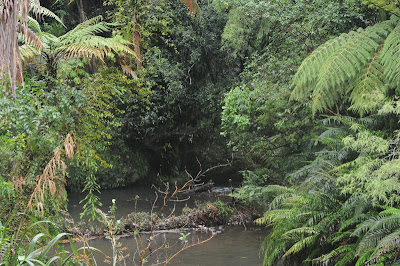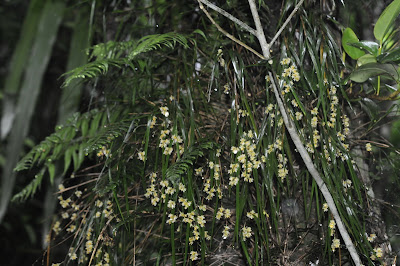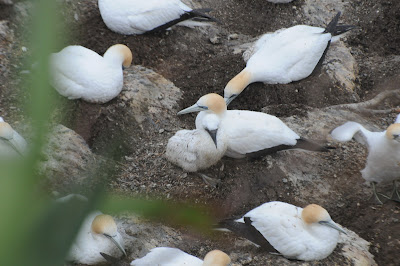After indulging myself on the Hauraki Gulf seabird-watching expedition, I felt it was only fair to share a bit of New Zealand nature with Ryan and Eileen. Besides, it was the day before the Society for Conservation Biology meeting - December 4, 2011 - and I knew that I was about to disappear into the bowels of the conference centre for the next five days. Accordingly, I had booked the three of us on an SCB field excursion to the Waitakere Ranges Regional Park, about 45 km north of Auckland.
I had, unfortunately, reckoned without the weather. It turns out that I had been exceedingly lucky to have had good weather on the previous day, because on the 4th it rained continuously (a harbinger, if I had only known, of what we were in for as we drove around the North Island the following week).
The park is a most attractive place full pf native vegetation, though the weather was not conducive to photography of sweeping landscapes!
The Waitakere Ranges Regional Park is the site of a unique conservation experiment: Ark in the Park. For many years, New Zealand conservationists have attempted to conserve rare species susceptible to introduced predators to predator-free offshore islands; many such species now survive only on such islands. Ark in the Park is one of several recent attempts to create a "mainland island" - a predator-free area on the mainland that can be used to expand the range of native birds and other animals. It has been a moderate success, though the bird on the sign - a Stitchbird (Notiomystis cincta) - is one of the birds that failed there, probably because some nest predators did get through. There are no current plans to return Stitchbirds to the area.
Visitors to Ark in the Park must be careful not to bring in weed seeds or other undesirable organisms. Ryan is following the rules by disinfecting his shoes before starting on the trail.
The reserve holds one of the remaining stands of what was once the dominant tree of North Island forests, the Kauri (Agathis australis). One of the main reasons for the disinfectant treatment is to prevent the spread of kauri dieback, a disease that threatens to kill off the last of the great trees.
Here, growing on a sapling, is a spray of kauri foliage.
Hanging clusters of narrow-leaved, cream-and-yellow flowered orchids decorated our pathway. This is apparently a member of the genus Earina, but I am not sure precisely which one. It resembles the Raupeka (Earina autumnalis), but that is an austral autumn bloomer and unlikely to have been flowering in December. Of the other two New Zealand species, it looks more to me like the Peka-a-waka (Earina mucronata), though from photographs that appears to have yellower flowers.
There weren't many birds about in the rain, but I might have expected that if one were to show up it would be one of the absurdly tame North Island Robins (Petroica longipes), especially with our guide's mealworms on offer. Like the birds I saw on Tiritiri Matangi (a genuine island) earlier in the year, this one was color-banded for individual recognition.
From Waitakere our group shifted down to the coast at Muriwai, home (between August and March) to 1200 nesting pairs of Australasian Gannets (Morus serrator) and one of only three gannet colonies on the mainland of New Zealand. It was still raining (and windy, and cold...) but Ryan remained an excellent sport about it all as we made our way down to the colony. So did Eileen, who followed us, gamely snapping photographs.
The birds have selected quite a spectacular piece of real estate for their nesting ground.
A viewing platform allowed us to watch the birds on the main stack...
...and to photograph a number of pairs at closer range below us (under, it must be said, rather trying conditions, but it was exciting all the same).
Unfortunately, the railing was at exactly the wrong height for Ryan...
...but, with a bit of ducking and weaving, we all had good views of the birds.
A few birds tended to growing, and particularly fluffy, young (they acquire their fluff within a week of hatching, but these young seem older than that).
The park is a most attractive place full pf native vegetation, though the weather was not conducive to photography of sweeping landscapes!
The Waitakere Ranges Regional Park is the site of a unique conservation experiment: Ark in the Park. For many years, New Zealand conservationists have attempted to conserve rare species susceptible to introduced predators to predator-free offshore islands; many such species now survive only on such islands. Ark in the Park is one of several recent attempts to create a "mainland island" - a predator-free area on the mainland that can be used to expand the range of native birds and other animals. It has been a moderate success, though the bird on the sign - a Stitchbird (Notiomystis cincta) - is one of the birds that failed there, probably because some nest predators did get through. There are no current plans to return Stitchbirds to the area.
Visitors to Ark in the Park must be careful not to bring in weed seeds or other undesirable organisms. Ryan is following the rules by disinfecting his shoes before starting on the trail.
The reserve holds one of the remaining stands of what was once the dominant tree of North Island forests, the Kauri (Agathis australis). One of the main reasons for the disinfectant treatment is to prevent the spread of kauri dieback, a disease that threatens to kill off the last of the great trees.
Here, growing on a sapling, is a spray of kauri foliage.
Hanging clusters of narrow-leaved, cream-and-yellow flowered orchids decorated our pathway. This is apparently a member of the genus Earina, but I am not sure precisely which one. It resembles the Raupeka (Earina autumnalis), but that is an austral autumn bloomer and unlikely to have been flowering in December. Of the other two New Zealand species, it looks more to me like the Peka-a-waka (Earina mucronata), though from photographs that appears to have yellower flowers.
There weren't many birds about in the rain, but I might have expected that if one were to show up it would be one of the absurdly tame North Island Robins (Petroica longipes), especially with our guide's mealworms on offer. Like the birds I saw on Tiritiri Matangi (a genuine island) earlier in the year, this one was color-banded for individual recognition.
From Waitakere our group shifted down to the coast at Muriwai, home (between August and March) to 1200 nesting pairs of Australasian Gannets (Morus serrator) and one of only three gannet colonies on the mainland of New Zealand. It was still raining (and windy, and cold...) but Ryan remained an excellent sport about it all as we made our way down to the colony. So did Eileen, who followed us, gamely snapping photographs.
The birds have selected quite a spectacular piece of real estate for their nesting ground.
A viewing platform allowed us to watch the birds on the main stack...
...and to photograph a number of pairs at closer range below us (under, it must be said, rather trying conditions, but it was exciting all the same).
Unfortunately, the railing was at exactly the wrong height for Ryan...
...but, with a bit of ducking and weaving, we all had good views of the birds.
A few birds tended to growing, and particularly fluffy, young (they acquire their fluff within a week of hatching, but these young seem older than that).
And it was still raining.


























No comments:
Post a Comment